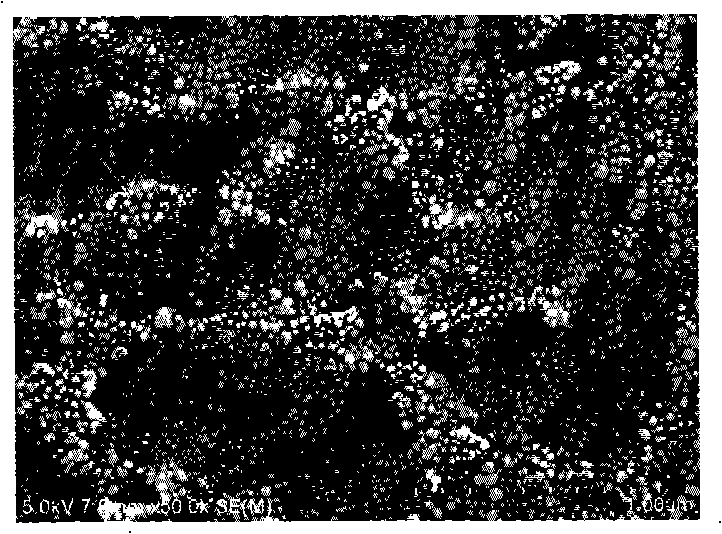Preparation method of monoclonal antibody coating biology stand
A monoclonal antibody and bio-stent technology, applied in liquid spraying equipment, stents, coatings, etc., can solve the problems of high restenosis rate, unsatisfactory long-term effect, strong thrombosis, etc., and achieve good stability and satisfy The effect of clinical needs and simple operation
- Summary
- Abstract
- Description
- Claims
- Application Information
AI Technical Summary
Problems solved by technology
Method used
Image
Examples
Embodiment 1
[0047] After polishing, 316 stainless steel alloy or cobalt complex alloy material was used to engrave a vascular stent with a laser, and the monoclonal antibody CD34-coated biological stent was prepared according to the following steps:
[0048] 1. Cleaning of the surface of the bracket body:
[0049] (1) Grinding the surface of the bracket body with an abrasive belt, mechanically removing oxides on the surface, and adjusting the surface roughness;
[0050] (2) Use ultrasonic waves to clean with 75% medical ethanol solution, 99.5% acetone solution, and deionized water in sequence. The ultrasonic frequency is 100KHz, and the cleaning time is 10 minutes;
[0051] (3) Soak the stent body in a 30g / L, 80°C sodium hydroxide solution for 10 minutes to remove grease and scale;
[0052] (4) Place the cleaned stent body in a vacuum dryer, set the temperature at 40° C., and take it out after drying for 45 minutes.
[0053] 2. Anti-corrosion treatment of the surface of the stent body: ...
Embodiment 2
[0060] After polishing, 316 stainless steel alloy or cobalt complex alloy material was used to engrave a vascular stent with a laser, and the monoclonal antibody CD133-coated biological stent was prepared according to the following steps:
[0061] 1. Cleaning of the surface of the bracket body:
[0062] (1) Grinding the surface of the bracket body with an abrasive belt, mechanically removing oxides on the surface, and adjusting the surface roughness;
[0063] (2) Use ultrasonic waves to clean with 75% medical ethanol solution, 99.5% acetone solution, and deionized water in sequence. The ultrasonic frequency is 28KHz, and the cleaning time is 15 minutes;
[0064] (3) Soak the stent body in a 60g / L, 70°C sodium hydroxide solution for 5 minutes to remove grease and scale;
[0065] (4) Place the cleaned stent body in a vacuum dryer, set the temperature at 30° C., and take it out after drying for 60 minutes.
[0066] 2. Anti-corrosion treatment on the surface of the bracket body:...
Embodiment 3
[0073] After polishing, 316 stainless steel alloy or cobalt complex alloy material is used to engrave a vascular stent with a laser; the surface of the stent is processed by chemical or physical methods, such as corrosion, anodic oxidation, micro-arc oxidation, micro-arc nitriding, etc. or a combination of these methods Holes are directly formed on the local surface of the raw material of the device body. The holes can be drug-loading grooves or pore structures, and the diameter of the holes is 100-800nm. Prepare the monoclonal antibody CD105-coated bioscaffold according to the following steps:
[0074] 1. Cleaning of the surface of the bracket body:
[0075] (1) Grinding the surface of the bracket body with an abrasive belt, mechanically removing oxides on the surface, and adjusting the surface roughness;
[0076] (2) Utilize ultrasonic waves to clean with 75% medical ethanol solution, 99.5% acetone solution, and deionized water successively, the ultrasonic frequency is 50KH...
PUM
| Property | Measurement | Unit |
|---|---|---|
| Diameter | aaaaa | aaaaa |
Abstract
Description
Claims
Application Information
 Login to View More
Login to View More - R&D
- Intellectual Property
- Life Sciences
- Materials
- Tech Scout
- Unparalleled Data Quality
- Higher Quality Content
- 60% Fewer Hallucinations
Browse by: Latest US Patents, China's latest patents, Technical Efficacy Thesaurus, Application Domain, Technology Topic, Popular Technical Reports.
© 2025 PatSnap. All rights reserved.Legal|Privacy policy|Modern Slavery Act Transparency Statement|Sitemap|About US| Contact US: help@patsnap.com



